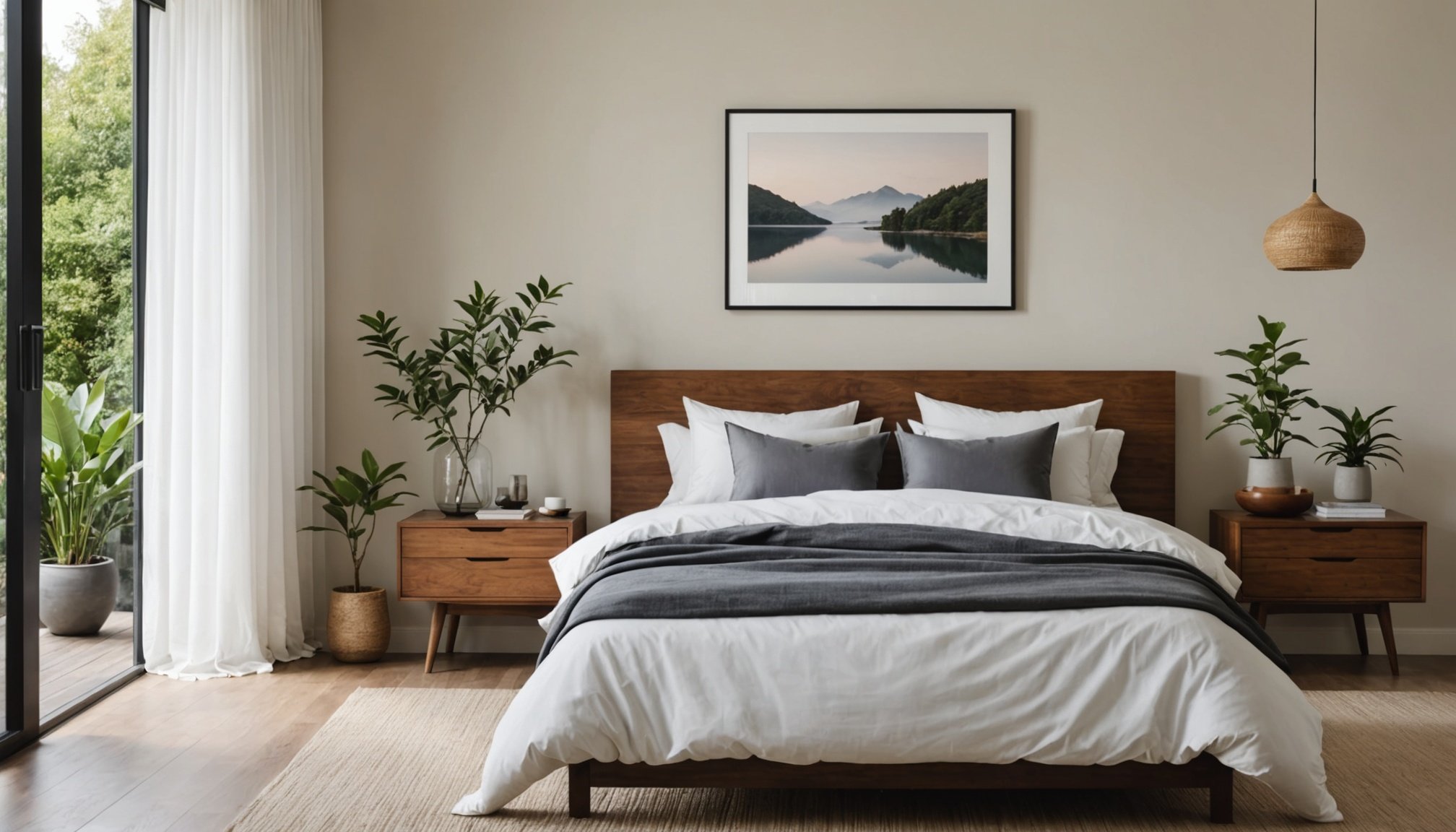Understanding the Principles of Zen Design
Incorporating Zen design principles into your home can create a tranquil environment that promotes peaceful aesthetics and mindfulness. One of the most crucial aspects of Zen design is the emphasis on simplicity and minimalism, which helps in reducing distractions and enhancing a sense of calm and clarity.
Natural elements, such as wood and stone, along with earthy colors, play a pivotal role in establishing a serene ambiance. These elements connect the interior with nature and create a soothing atmosphere. Consider using plants and natural decorations to add a touch of nature within the confines of your living space.
Also to read : Transform your space: boost indoor air quality with salt lamps and live air-purifying plants
Balance and harmony are core components of Zen design choices. This involves not only the arrangement of furniture and decor but also the selection of textures and materials that complement one another. Strive for symmetry and clean lines to create a sense of order and stability.
To sum up, integrating Zen design principles is about more than just aesthetics; it’s about creating an intentional space where mindfulness in decor can be experienced daily. With thoughtful design choices, a tranquil retreat can easily be achieved in any living area.
Also read : Brilliant energy-saving lighting solutions to brighten your extended hallway
Selecting the Right Color Palette
Choosing the right calming colors is essential to fostering Zen-inspired environments. Calming hues such as soft blues, muted greens, and gentle beiges promote relaxation and mindfulness by creating a sense of serenity. These colors have a soothing psychological impact, helping to diminish stress and enhance the tranquil ambiance of one’s space.
Given the role of color psychology, integrating both light and dark shades can significantly alter a room’s atmosphere. Light colors open up spaces, creating an airy feel, whereas carefully chosen dark colors add depth and coziness. Balance is key. By combining these, one can achieve a harmonious blending that feels welcoming and peaceful.
Effectively using colors calls for subtlety – achieve this by layering various hues within a similar palette. Consider incorporating accents or natural materials that complement the primary colors. This approach can give a room a unified feel while subtly guiding the eye and encouraging mindfulness.
While it is tempting to experiment with a multitude of colors, restraint often yields the best results in Zen design. Ensuring that every color brings a serene atmosphere is crucial for crafting a truly calming space.
Essential Furniture Choices
To create a Zen-inspired space that exudes tranquility, selecting the right functional furniture is crucial. Prioritizing comfort and functionality can transform your living area into a haven of relaxation. For seating and bedding, choose pieces that offer support without sacrificing comfort. Utilising low-profile furniture designs ensures a sense of openness within the room.
When focusing on Zen design, opt for versatile furniture that maximizes space efficiency. Multi-functional items, such as extendable tables or storage beds, are excellent choices for maintaining simplicity without cluttering your space. This approach not only supports a minimalist aesthetic but also enhances the overall functionality of the room.
Consider incorporating zen-inspired pieces that bring warmth and texture into your home. Natural materials like bamboo, rattan, or reclaimed wood lend authenticity and connect the interior with the natural world. Low tables and tatami mats can also help reinforce the principles of Zen by encouraging a floor-level lifestyle.
Ultimately, choosing furniture that aligns with these principles allows you to craft a space that feels harmonious, fulfilling the need for both comfort and peace. This balance is pivotal in achieving a truly peaceful and functional environment that resonates with Zen aesthetics.
Decor Elements for Tranquility
Creating a tranquil environment is often facilitated through carefully chosen decor elements. These choices should foster a sense of peace and mindfulness. Selecting zen decor involves choosing artwork and decor that promote a serene and soothing atmosphere. Opt for pieces that exude calmness, steering away from overly bold or vibrant artwork which can disrupt the peaceful ambiance.
Incorporating handmade or natural objects adds a personal touch to your space. Such pieces, imbued with uniqueness and craft, may include ceramics, wooden sculptures, or woven baskets. These objects resonate with the values of authenticity and simplicity inherent in Zen design. They enrich the space while serving as gentle reminders of the interconnectedness with nature.
Textiles play a pivotal role, offering comfort and inviting warmth. When selecting fabrics, aim for natural materials like cotton or linen. These not only provide texture but also enhance practicality within the space. Drapes, cushions, or throws in subtle tones can complement the existing design flawlessly.
By combining these thoughtful decor ideas, a space can achieve harmony and tranquility, enveloping occupants in a comforting embrace of serenity.
Enhancing Ambiance with Lighting
In cultivating a Zen-inspired space, lighting options are crucial for setting the right mood. Soft lighting fosters a tranquil environment, creating an atmosphere conducive to relaxation. Natural light is preferable as it mirrors the gentle radiance found in nature. Consider positioning furniture to maximize sunlight exposure during the day. Complement this with strategically placed lamps or candles for the evenings, allowing flexibility in how the space feels.
The choice between natural and artificial lighting significantly impacts room ambiance. While natural light offers a serene warmth, artificial lighting should mimic this effect. Select light bulbs with warm tones, steering clear of harsh, fluorescent lighting. This helps maintain a soothing and peaceful atmosphere.
Layering light sources enhances versatility, allowing you to adjust the mood as needed. Incorporating adjustable lamps, dimmers, or string lights can help blend various lighting sources smoothly. This approach supports a dynamic interplay of light, enriching the overall design principles.
Effective lighting unites all elements of Zen decor, reinforcing a harmonious and relaxing environment. By understanding and utilizing diverse lighting options, one can artfully enhance ambiance, enveloping the room in a calming glow.
Incorporating Zen-Inspired Scents
Aromas can significantly influence the peaceful aesthetics of your space. Incorporating calming scents through diffusers, candles, or incense, enhances the environment by adding an olfactory layer of tranquility. Diffusers offer a continuous release of fragrance, making them ideal for maintaining a consistent backdrop of serenity. On the other hand, candles and incense provide more sporadic scents that can be used in specific moments of relaxation or meditation.
Choosing the right essential oils is crucial in promoting relaxation and mindfulness in decor. Popular options include lavender, which is renowned for its calming properties, eucalyptus for refreshing the mind, and sandalwood for grounding and improving focus. Each scent has its own unique benefits and can be selected based on personal preference and desired effects within the room.
Beyond scent, air quality plays an essential role in fostering a calming environment. To ensure a breathable and refreshing atmosphere, consider integrating air-purifying plants like peace lilies or snake plants, which naturally improve air quality. Combining aromatic elements with a commitment to fresh air creates an inviting and soothing sanctuary. Achieving balance in fragrances and air quality ensures the Zen-inspired space remains a cornerstone of peace and relaxation.
Sound and Its Role in Creating Peace
Successfully creating a tranquil space involves attentively choosing the right sound ambiance. Incorporating calming sounds such as soft music or nature soundscapes can significantly enhance the room’s serenity. These sounds promote relaxation and mindfulness, offering a soothing background that helps mask external disturbances.
Nature sounds, like flowing water or chirping birds, are particularly effective in creating a peaceful atmosphere. Consider integrating water features in guest rooms to deepen the sense of tranquility. The gentle trickle of a small indoor fountain not only adds an auditory layer of calm but also introduces an appealing visual element.
Managing noise pollution is crucial for preserving the serene environment. To reduce unwanted sounds, use soft furnishings like thick rugs and curtains, which can absorb noise. Double-glazed windows or acoustic panels may also be employed for further sound insulation.
Incorporating sound-specific strategies can transform any room into a peaceful retreat. By thoughtfully selecting and managing sound elements, one can significantly elevate the ambiance of a space, making it more welcoming and conducive to relaxation.
Practical Maintenance for a Zen Haven
Creating and maintaining a Zen-inspired space requires room maintenance that supports its calming essence. A key aspect of this maintenance is decluttering tips. Keeping surfaces free of unnecessary items helps promote a serene atmosphere. Regularly assess belongings, retaining only those that enhance the tranquility of the space.
In addition to decluttering, regular cleaning is paramount for preserving the peaceful aesthetics of the room. Dust and dirt not only disrupt the visual quietness but can also impede air quality. Schedule routine cleaning tasks, such as dusting, vacuuming, and air purification, to ensure the environment remains refreshing.
Strategically organizing can significantly simplify guest room spaces. One effective method is to use multifunctional storage solutions—like ottomans with hidden compartments or shelves that double as decorative elements. This approach not only keeps the area tidy but also maximizes the utility of existing furniture.
Inculcating these practices ensures that the space remains a true Zen haven, enabling relaxation and mindfulness without distraction. By making small yet impactful changes, the overall ambiance can be maintained, allowing the tranquility of the Zen design principles to flourish consistently.







